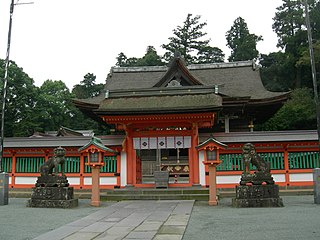 W
WIn Japanese religion, Yahata formerly in Shinto and later commonly known as Hachiman is the syncretic divinity of archery and war, incorporating elements from both Shinto and Buddhism.
 W
WEmperor Chūai , also known as Tarashinakatsuhiko no Sumeramikoto (足仲彦天皇) was the 14th legendary Emperor of Japan, according to the traditional order of succession. Both the Kojiki, and the Nihon Shoki record events that took place during Chūai's alleged lifetime. Chūai is the first monarch to ascend the throne who was not a son of the previous Emperor as the latter's only child died young. He is also noted for having his capital in Kyushu, rather than Yamato like his predecessors. The records state that Chūai had a wife named Okinagatarashihime-no-Mikoto, and 2 consorts that all bore him 4 children.
 W
WA Hachiman shrine is a Shinto shrine dedicated to the kami Hachiman. It is the second most numerous type of Shinto shrine after those dedicated to Inari Ōkami. There are about 44,000 Hachiman shrines.
 W
WMount Hachimantai is the highest peak of a group of stratovolcanos distributed around the Hachimantai plateau in the Ōu Mountains in northern Honshū, Japan. This volcanic plateau is part of the Nasu Volcanic Zone and straddles the border between the Iwate Prefecture and Akita Prefecture. The volcano is listed as one of the 100 Famous Japanese Mountains, and forms part of the Towada-Hachimantai National Park.
 W
WEmpress Jingū was a legendary Japanese empress who ruled as a regent following her husband's death in 200 AD. Both the Kojiki and the Nihon Shoki record events that took place during Jingū's alleged lifetime. Legends say that after seeking revenge on the people who murdered her husband, she then turned her attention to a "promised land". Jingū is thus considered to be a controversial monarch by historians in terms of her alleged invasion of the Korean Peninsula. This was in turn possibly used as justification for imperial expansion during the Meiji period. The records state that Jingū gave birth to a baby boy whom she named Homutawake three years after he was conceived by her late husband.
 W
WJōten-ji (承天寺) is a Rinzai temple in Hakata, Fukuoka, Japan. Its honorary sangō prefix is Banshōsan (萬松山). It was founded by Enni-Ben'en with support from Xie Guo Ming, a Chinese merchant, and construction was completed in 1242.
 W
WKōra taisha (高良大社) is a Shinto shrine in Kurume, Fukuoka Prefecture, Japan.
 W
WEmperor Ōjin , also known as Hondawake no Mikoto (誉田別尊) or Homuta no Sumeramikoto (譽田天皇), was the 15th legendary Emperor of Japan, according to the traditional order of succession.
 W
WTakenouchi no Sukune (武内宿禰) or Takeshiuchi no Sukune was a legendary Japanese hero-statesman of the 1st century, and a Shinto kami.
 W
WTamukeyama Hachiman Shrine is a Shinto shrine near Tōdai-ji, Nara, Nara Prefecture, Japan. It is a Hachiman shrine, dedicated to the kami Hachiman. It was established in 749. Kami enshrined here include Emperor Ojin, Emperor Nintoku, Empress Jingū and Emperor Chūai in addition to Hachiman.